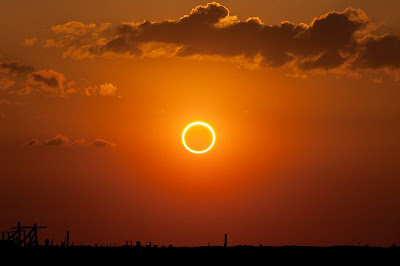 |
| Seriously, what the heck? |
.....On August 14th, Japanese astronomer Koichi Itagaki took an image of this part of the sky, and saw the image of a star that had not been visible the previous night. Over the following nights, the star brightened to a magnitude of about 4.5 (a faint but definitely visible star if you have a decent sky, sketchy in a suburban sky, and a vain hope for city skies). While it has dimmed a bit, and while the brightening moon is watching out all but the brightest stars, no matter why you are watching this from, the nova is easily findable in binoculars.
.....Delphinus is a small constellation, and it does not have any bright stars, but it is still relatively easy to find. Here is a view of the summer triangle, below.
.....Delphinus is outside the triangle proper, close to Altair in Aquila. While it does not have any really bright stars, the five primary stars are so close together in the sky that the constellation is relatively easy to find. Find the Summer Triangle, start from Altair (the southern point on the triangle, look to the east and slightly north, and you should be able to find the Dolphin fairly quickly. Even if you are looking tonight, when the Moon is bright and near the constellation, Delphinus is compact enough that I hope you can find the constellation in binoculars, with most (if not all) of the figure visible at the same time. Now let us zoom in on Delphinus
.....Allow me to toss in a word about constellations versus asterisms. A constellation is as "official" as it gets. The official set of 88 constellations were designated by the International Astronomical Union in 1930, along with official boundaries. the boundaries are useful in marking which things happen in which constellation. For example, this is Nova Delphinus 2013 - even though the nova is well away from the traditional lines tracing out the figure, the nova is still inside the borders of Delphinus. An asterism is any pattern that is not a constellation, but is still helpful or popular enough to use. The most famous asterism is the Big DIpper; This is but a part a of the constellation of Ursa Major, but the biggest and brightest part. Many people who could not trace out the rest of Ursa Major can find the Big Dipper easily enough.
.....The asterism that I am adding to help find the nova looks to my mind something like the constellation of Hercules, so I am naming this asterism "Argolese". No, not out of any part of mythology. I'm going to the series of weak Italian strongman movies repackaged for America as the "Sons of Hercules" series. (If you are going to watch it, watch it through here.)
.....To give directions, I'm going to need to refer get more specific than just "Delphinus", or even "Argolese". I'm going to have to give directions using the stars themselves, so I'm going to need names. Here is a map showing the names assigned to these stars:
.....The Greek letters, as I have explained before, are one way to identify stars without giving individual "names" to each one. You might also notice that the names of the two stars that do have names have strangely appearing names. Most stars with individual names have Arabic names, with some Greek and Latin. What is up with "Sualocin" and "Rotanev"? These come from Niccolo Cacciatore, an Italian astronomer making a star catalog who Latinized his own name (into Nicolaus Venator) and slipped it into the catalog. (But not as "Nicolaus" and "Venator", no, that would just be silly ...)
.....Draw an imaginary line from d Delphinii through Sualocin and track that outward. "Argolese" should appear above the line, and the nova will (at least of tonight) be notably brighter than any of the stars around it.
.....So what is this thing, assuming that it is a classical nova?
.....Consider a pair of stars orbiting a common center of mass. One of stars, the more massive one, goes through its evolution more quickly, reaching and passing the point at which all of its outer mass is cast off (a good deal of that mass being cast off ends up on the companion), and the cooling core is left as a white dwarf. Now observe the orbit decay, and the two stars spinning closer to each other, so close that the companion star is squeezed, matter starting to dump towards the white dwarf. But the stars are moving so quickly that the stream of matter misses the white dwarf, and is caught up in a disk around the white dwarf.
.....This disk will keep building over time, until the pressure builds to the point where the hydrogen would begin to fuse into helium, releasing energy in the way that a active star does. When matter surrounding the core of a star in the form of, say, a star, undergoes fusion, the outer envelope of the star holds it together through pressure. Since the disk is only the cross-section of a star, the fusion consumes and destroys the disk, releasing a tremendous amount of energy for few weeks, and then, in most cases simply starts all over again with a new, forming disk. And this is what you'd be looking at in Delphinus right now.









